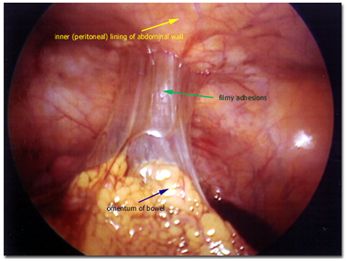Abdominal Adhesions Causes, Symptoms, Diagnosis and Treatment

What is Abdominal Adhesions?
Abdominal adhesions are bands of fibrous scar tissue that form on organs in the abdomen, causing the organs to stick to one another or to the wall of the abdomen. Normally, internal tissues and organs have slippery surfaces, which allow them to shift easily as the body moves. However, abdominal adhesions cause tissues and organs in the abdominal cavity to stick together.
When adhesions form, the intestines are no longer able to move around freely because they become tethered to each other, the abdominal wall or to other abdominal organs. At the sites where adhesions occur, the intestine can twist on itself, and the twisting may obstruct the blood supply or the normal movement of its contents, particularly in the small intestine. Most of the time the twisting is intermittent, but occasionally the twisting does not reverse spontaneously.
Causes of Abdominal Adhesion
Abdominal surgery is the most incessant reason for abdominal adhesions. Surgery-related causes include
- cuts involving internal organs
- handling of internal organs
- drying out of internal organs and tissues
- contact of internal tissues with foreign materials, such as gauze, surgical gloves, and stitches
- blood or blood clots that were not rinsed away during surgery
Abdominal adhesions can also result from inflammation not related to surgery, including
- appendix rupture
- radiation treatment
- gynecological infections
- abdominal infections
Related article: What is Infected Abdominal Adhesions: Natural Treatment
Symptoms of Abdominal Adhesion
In most cases, abdominal adhesions do not cause symptoms. When symptoms are present, chronic abdominal pain is the most widely recognized.
More significant intestinal obstruction can bring about the accompanying symptoms:
- Severe, crimpy abdominal pain
- Nausea and vomiting
- Swelling of the abdomen (abdominal distension)Inability to pass gas and absent or infrequent bowel movements
- Signs of dehydration, including dry skin, dry mouth and tongue, severe thirst, infrequent urination, fast heart rate and low blood pressure
Diagnosis of Abdominal Adhesions
There are no tests that can clearly identify adhesions, but the pattern of impediment can be perceived on plain X-ray films of the abdomen by the presence of dilated loops of small intestine. Contrast X-rays of the small intestine, specifically the use of small bowel follow through examination, may show abnormal angulations of the intestinal loops that suggest the presence of adhesions. Such a finding, however, does not mean that the adhesions necessarily are responsible for the symptoms.
Other tests such as ultrasonugraphy and computerized tomography (CT) are regularly important, basically to reject different reasons for obstacle, for example, tumors and strictures (gut narrowing).
Treatment of Abdominal Adhesions
Following are the treatment options available for abdominal adhesions:
Non-surgical treatment
Most partial intestinal obstructions can be managed without surgery.
- Over the counter pain killers such as paracetamol and ibuprofen
- Low fiber food
Related article: What is the best Pain Relief for Abdominal Adhesions
Surgical treatment
- Complete intestinal obstructions usually require immediate surgery to clear the blockage
By : Natural Health News




